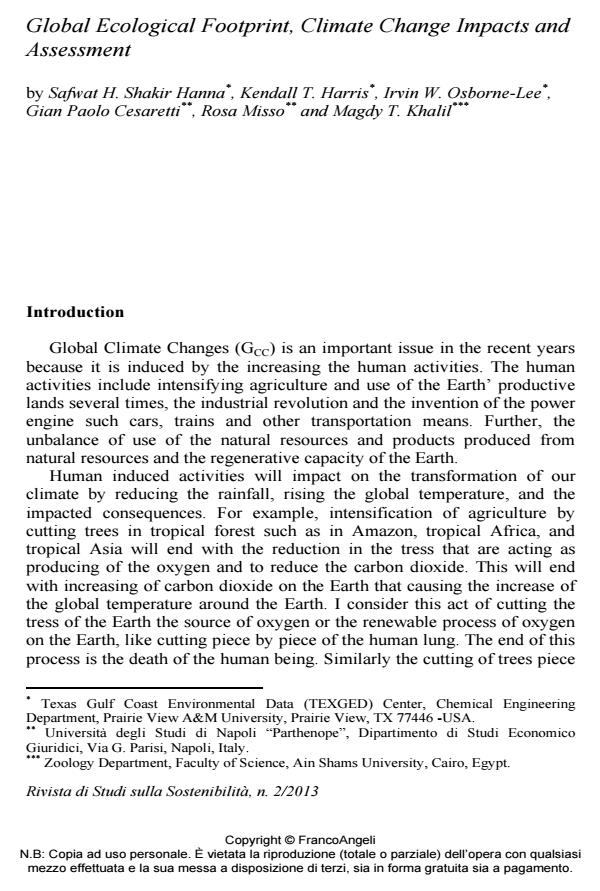Global Ecological Footprint, Climate Change Impacts and Assessment
Titolo Rivista RIVISTA DI STUDI SULLA SOSTENIBILITA'
Autori/Curatori Hanna Safwat H. Shakir, Kendall T. Harris, Irvin W. Osborne-Lee, Gian Paolo Cesaretti, Rosa Misso, Magdy T. Khalil
Anno di pubblicazione 2014 Fascicolo 2013/2
Lingua Inglese Numero pagine 30 P. 9-38 Dimensione file 1391 KB
DOI 10.3280/RISS2013-002002
Il DOI è il codice a barre della proprietà intellettuale: per saperne di più
clicca qui
Qui sotto puoi vedere in anteprima la prima pagina di questo articolo.
Se questo articolo ti interessa, lo puoi acquistare (e scaricare in formato pdf) seguendo le facili indicazioni per acquistare il download credit. Acquista Download Credits per scaricare questo Articolo in formato PDF

FrancoAngeli è membro della Publishers International Linking Association, Inc (PILA)associazione indipendente e non profit per facilitare (attraverso i servizi tecnologici implementati da CrossRef.org) l’accesso degli studiosi ai contenuti digitali nelle pubblicazioni professionali e scientifiche
Ecological footprint (EF) is an important measure in calculating the human demands and impacts on our global environment. In this respect, the ecological footprint is a function of all the parameters that interact between the power of ecosystem productivity and human interactions and activities on a particular ecosystem or the demand from that ecosystem. The present paper will cover and analyses the ecosystems’ productivity and the human demand from the ecosystems. It will produce comprehensive analyses in measuring the possibility of capabilities of the ecosystems to provide goods and services to the human beings on our planet Earth. Further, the paper will discuss the models that can be used in measuring the sustainability of ecosystem, climate changes and what we should be doing to maintain the Earth healthy ecosystems. In this respect, the paper will assess and introduce a comprehensive model called Global Ecological Footprint and climate change (GEF-CH) that can describe the status of our ecosystems’ productivities and the impacts of climate change and global human population Earth boundaries. Furthermore, the paper will provide some answers to the human issues globally; Climate change impacts as the results of human activities. Further, warning to the current trend in use and abuse of our natural ecosystems and what will be expecting from these ecosystems to provide the human needs in response to the current use of global ecosystems' existence.
L’impronta ecologica è una misura importante per il calcolo delle esigenze umane e per valutare l’impatto sul nostro ambiente globale. Il presente lavoro analizza la produttività degli ecosistemi e ciò che l’umanità richiede dagli ecosistemi; esso tratta dei modelli che possono essere utilizzati per misurare la sostenibilità degli ecosistemi, i cambiamenti climatici e di ciò che occorre fare per mantenere la salute degli ecosistemi terrestri. In particolare, il documento propone un modello globale chiamato "Global Ecological Footprint and climate change" (GEF-CH) in grado di descrivere lo stato della produttività dei nostri ecosistemi, gli impatti del cambiamento climatico ed i limiti della popolazione umana globale della Terra. Il lavoro propone diverse spunti di riflessione per evitare impatti irreversibili degli esseri umani sugli ecosistemi e sul nostro ambiente globale, tra cui l’impatto del cambiamento climatico.
Parole chiave:Cambiamento climatico globale, impronta ecologica produttività ecosistemi, popolazione umana globale, sostenibilità, Modello cambiamento climatico e impronta ecologica (GEF-CH)
- The Theory of Sustainable Development: A Review Safwat H. Shakir Hanna, Gian Paolo Cesaretti, in RIVISTA DI STUDI SULLA SOSTENIBILITA' 2/2020 pp.13
DOI: 10.3280/RISS2019-002004 - Towards a Universal Right to Well-being Sustainability Gian Paolo Cesaretti, Maria Carmen de Angelis, Rosa Misso, Aquilina Olleia, Hanna Safwat H. Shakir, in RIVISTA DI STUDI SULLA SOSTENIBILITA' 1/2015 pp.9
DOI: 10.3280/RISS2015-001002 - Spatial and Temporal Variations in the Ecological Footprints in Northwest China from 2005 to 2014 Yunhe Yin, Xiang Han, Shaohong Wu, in Sustainability /2017 pp.597
DOI: 10.3390/su9040597
Hanna Safwat H. Shakir, Kendall T. Harris, Irvin W. Osborne-Lee, Gian Paolo Cesaretti, Rosa Misso, Magdy T. Khalil, Global Ecological Footprint, Climate Change Impacts and Assessment in "RIVISTA DI STUDI SULLA SOSTENIBILITA'" 2/2013, pp 9-38, DOI: 10.3280/RISS2013-002002